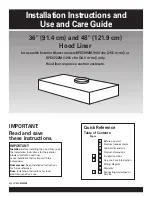
5
About Call2Recycle Battery Seals
Call2Recycle’s industry steward program helps
battery and product manufacturers fulfill recycling
requirements in the U.S. and Canada, including
compliance with extensive state, provincial and
federal regulations, such as the Mercury-
Containing and Rechargeable Battery Act (The
Battery Act). Call2Recycle
®
Licensees/Industry
Stewards, participating battery and product manufacturers and
marketers, purchase the rights to imprint the Call2Recycle Battery
Seals on their rechargeable batteries and products. When you see the
Call2Recycle Battery Seal, you can feel confident knowing that your
battery or product can be safely and responsibly recycled.
About Call2Recycle
Since 1994, Call2Recycle has diverted more than 75 million pounds
of rechargeable batteries from local landfills and established a
network of 30,000 recycling drop-off locations. More than 200 battery
and/or product manufacturers, Call2Recycle Industry Stewards, have
united to ensure that batteries are responsibly recycled when they
reach their end of life and fund the program that is operated by
Call2Recycle, Inc., a 501(c)4 nonprofit public service organization.
To locate the nearest recycling center, please call
1-800-822-8837
.
WHILE OPERATING
•
Wear safety glasses or goggles that meet current ANSI / ISEA
Z87.1 standards and are marked as such. Wear ear/hearing
protection when operating this unit. Wear a face mask or dust
mask if the operation is dusty.
•
Wear heavy long pants, boots, gloves and a long sleeve shirt. Do
not wear loose clothing, jewelry, short pants, sandals or go
barefoot. Secure hair above shoulder level.
•
Use the unit only in daylight or good artificial light.
•
Use the right tool. Only use this tool for its intended purpose.
•
Always hold the unit with a firm grip when operating.
•
Do not overreach. Always keep proper footing and balance. Take
extra care when working on stairs, steep slopes or inclines. To
avoid serious injury, do not operate the unit while on a ladder or
a roof.
•
Keep hair, face, hands, feet and all other body parts away from
moving parts and openings. Do not touch or try to stop moving
parts.
•
Do not operate the unit faster than the speed needed to do the
job. Do not run the unit at high speed when not in use.
•
Do not force the unit. It will do a better, safer job when used at
the intended rate.
•
Always turn the unit off when operation is delayed or when
carrying the unit from one location to another.
•
Before setting the unit down, always turn the unit off and wait for
all moving parts to come to a complete stop.
•
Avoid starting the unit unintentionally. Make sure your fingers are
off the trigger before installing or removing the battery. Never
carry the unit with fingers on the trigger.
•
Remove the battery from the unit when it is not in use.
•
Do not use the unit if the trigger does not start and stop the unit.
•
If the unit strikes or becomes entangled with a foreign object,
stop the motor immediately, remove the battery and check for
damage. If damaged, do not restart or operate the unit until it is
repaired. Do not operate the unit with loose or damaged parts.
•
Use only original equipment manufacturer (OEM) replacement
parts and accessories for this unit. These are available from your
authorized service dealer. Use of any other parts or accessories
could lead to serious injury to the user, or damage to the unit,
and void the warranty.
•
Keep the unit clean. Stop the motor, remove the battery and
allow the unit to cool. Carefully remove vegetation and other
debris that could block moving parts.
•
If the unit starts to vibrate abnormally, stop the motor, remove the
battery and allow the unit to cool. Inspect the unit for the cause of
the vibration. Vibration is generally an indicator of trouble.
WARNING:
To reduce the risk of electric
shock, do not expose the unit to rain or wet conditions.
Store the unit indoors.
FCC STATEMENT
NOTE:
This equipment has been tested and found to comply with the
limits for a Class B digital device, pursuant to part 15 of the FCC
Rules. These limits are designed to provide reasonable protection
against harmful interference in a residential installation. This
equipment generates, uses and can radiate radio frequency
energy and, if not installed and used in accordance with the
instructions, may cause harmful interference to radio
communications. However, there is no guarantee that interference
will not occur in a particular installation. If this equipment does
cause harmful interference to radio or television reception, which
can be determined by turning the equipment off and on, the user
is encouraged to try to correct the interference by one or more
of the following measures:
— Reorient or relocate the receiving antenna.
— Increase the separation between the equipment and receiver.
— Connect the equipment into an outlet on a circuit different
from that to which the receiver is connected.
— Consult the dealer or an experienced radio/TV technician for help.
CAUTION:
Changes or modifications not
expressly approved by the party responsible for compliance
could void the user's authority to operate the equipment.






































